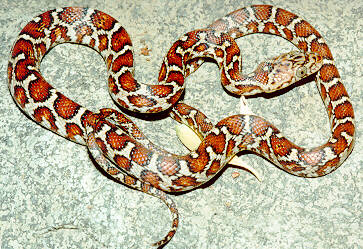
Elaphe flavirufra (Cental American Ratsnake)

juvenile E.f.pardalina, photo courtesy Lloyd Lemke
Written by Tony Baum
The species Elaphe flavirufa is presently represented by five poorly defined subspecies, Elaphe f. flavirufa, Elaphe f. pardalina, Elaphe f. phaescens, Elaphe f. polysticha and Elaphe f. matudai. Only two of which are commonly found in herpetaculture today, Elaphe f. flavirufa and Elaphe f. pardalina. It is possible that Elaphe f. polysticha is out there but I have not yet found it. It is also possible that there are Elaphe f. phaescens in Europe. I have not been able to verify this yet.
Common Names:
Elaphe f. flavirufa : Mexican Ratsnake, Tamaulipan Ratsnake, Nightsnake
Elaphe f. pardalina: Central American Ratsnake, Honduran Ratsnake, Central American Cornsnake, Corn Island Ratsnake, Nightwalker,
Elaphe f. phaescens: Yucatan Ratsnake, Nightsnake
Elaphe f. polysticha: Bay Islands Ratsnake, Nightwalker
Elaphe f. matudai: I am not aware of any common name for this subspecies.
Range:
Elaphe f. flavirufa: Gulf of Mexico, Coastal plains and lowlands of Mexico from Tamaulipas to the vicinity of Campeche. One specimen was collected in 1952 from the Pacific coast of Mexico in Tehuantepec Oaxaca.
Elaphe f. pardalina: Found on the Caribbean Gulf Coast of Belize, Guatemala, Honduras, and Nicaragua. Also found on some coastal islands notably, Corn Island Nicaragua.
Elaphe f. phaescens: Found on the Yucatan peninsula, Mexico around Chichen Itza, Valladolid, Yucatan and Puerto Juarez, Quintana Roo Mexico.
Elaphe f. matudai: Known only from the holotype collected by Hobart Smith in 1941 at Chiapas, Mexico (on the Pacific slope of Mexico) , until 1997 when another specimen collected at San Jeronimo, Chiapas Mexico in 1970 by E.C. Welling was described by Schultz, Smith et el.
Elaphe f. polysticha: Found only on the Bay Islands, Honduras.
Habitat:
Coastal Plains and lowlands at elevations of 0 to 500 meters (1500 feet). In moist as well as tropical dry forest.
Behavior:
A rather quick, nervous snake, which moves constantly while being handled. They are not usually flighty, and they rarely offer to bite. These animals fare better if not kept together except for breeding. A hide box is required and is well used. They are primarily nocturnal (given the name Nightwalker in Honduras), and at least partially arboreal, although most, if not all specimens are collected on the ground.
Size:
A slender bodied snake that attains a length of 5 to 51/2 feet, they have very long tails up to 28% of total body length. The northern form Elaphe f. flavirufa seems to reach only 3 to 4 feet in length.
Wild Type Coloration:
Variable, neonates are usually more brightly colored. The color is more subdued in adults. Ground color ranges from yellow and tan to light brown and gray or silver, sometimes with a pinkish or orange wash overall. Dorsal and lateral blotches range in color from brick or terra cotta red to light or dark brown to a grayish brown. All have a dark brown or black border. The ventor is yellowish to grayish tan with a small number of brown or gray spots. The iris of the eye is a gray green color.
Pattern:
The basic pattern is made up of 29 to 46 dark edged, light centered dorsal blotches, many of which are confluent with adjacent blotches and form an interrupted zigzag stripe. This makes the blotches in some cases almost impossible to count.
Color morphs:
There is an anerytheristic morph of Elaphe f. flavirufa. These have a light silver background color with black blotches. These are very pretty animals. The eyes of this morph are dark.
General:
Elaphe flavirufa is closely allied with Elaphe g. emoryi based on hemipenal morphology. However, where their ranges overlap in Tamaulipas and San Louis Potosi, Mexico, they remain distinct, with no indication of subspecific relationship. The species flavirufa is distinguished from other new world Elaphe by their elongated snout, large eyes, long relative tail length, split preoculars (in southern populations), higher ventral and subcaudal counts and a nearly patternless ventral surface (although I have seen a neonate with a black ventral surface). The ventral and subcaudal counts increase clinally from north to south. There is a clinal bias for split preoculars in the southern portion of the population.
Subspecies:
Elaphe f. flavirufa: Usually have single preocular scales, although sometimes they may have one or both preocular scales split. There are usually less than 260 ventral scales. There are generally more than 31 dorsal blotches.
Elaphe f. pardalina: Usually both preocular scales are split. Occasionally only one and rarely neither preocular scale is split. Usually more than 260 ventral scales. There are generally fewer than 32 dorsal blotches.
Elaphe f. phaescens: Normally there are 30 or fewer dorsal blotches, dark chocolate brown in color. Dorsal scale count: minimum anterior 29, minimum posterior 23. There may be 25 in females. Lower number of caudal scales than found in other subspecies. Dorsal scales are slightly more keeled.
Elaphe f. matudai: Compares with Elaphe f. pardalina in scale counts, divided preocular scales and color. They differ only in dorsal pattern. In E. f. matudai the dorsal and lateral blotches merge into a single saddle. Occasional specimens of Elaphe g. guttata from south Georgia and north Florida (to which flavirufa are closely related) exhibit a similar pattern anomaly. This and the fact that only two specimens of E.f. matudai have been collected in 57 years suggest that these individuals may be aberrant Elaphe f. pardalina and not a separate subspecies.
Elaphe f. polysticha: The only specimens collected so far have been found on the Island of Roatan, Bay Islands, Honduras. All of the specimens parallel E. f. pardalina in terms of color, pattern, ventral scale numbers and divided preocular scales. The distinctive feature of E. f. polysticha is the higher average number of scale rows, a maximum of 34 with a posterior minimum of 23. E. f. pardalina has a maximum of 31 scale rows with a posterior minimum of 21.